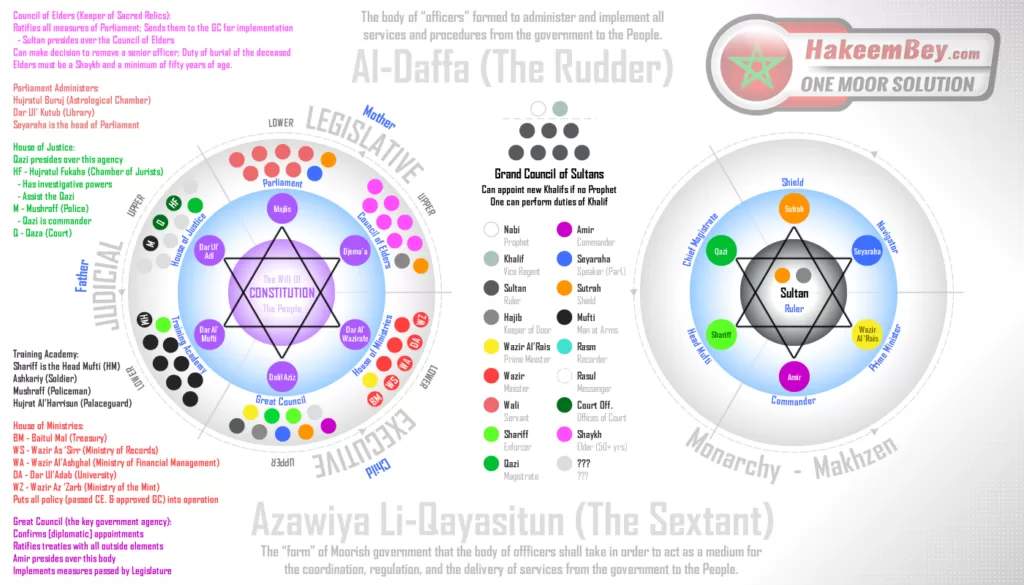The Moorish Rudder and Sextant outlines the structure of Moorish government in accordance with Moorish Science. It’s highly recommended that all Moors / Moslems are aware of the contents of this concise book. I’ve taken the liberty to create an audiobook to allow for easier consumption of the knowledge it contains.
Additionally, I’ve drafted a detailed diagram for Moors to visualize the governmental structure outlined in the Moorish Rudder and Sextant. Feel free to download the image to keep it as a reference. All I ask is that it not be altered or used in any medium for commercial purposes without my express written consent.
Introduction
The rudder and sextant began as an idea to translate the titles and positions of the administration that we function under, into our cultural customs or holy names.
The project began with the revelation of the rudder of the Moorish Coat of Arms, on the twelfth of February, nineteen eighty-six, progressed into it’s research stages, and was completed with the publication of the rudder and sextant, a legal blueprint on the subjects of Islamic government and Moorish heraldry.
Completed on December 23rd 1987, it was a twenty-two month project, which has been completed in time for the new administration. It’s author was born in the year the Moorish law was revealed.
We hope this little book becomes an inspiration for both initiates and the doctors of the law.
I Am
Bro. Bashiri A. Malik El
“A free Moor”
IN THE NAME OF ALLAH
THE BENEFICENT, THE MERCIFUL
To: The Great Seal National Association Of Moorish
Affairs And The Citizens Of The Moorish Nation
Greetings: As-salaam Alaikum Wa Rahmatullahi Wa Barakatu.
(Peace be upon you and the mercy of Allah and his blessings.)
From: Brother Bashiri Abdul Malik-El
(Katib: Publisher,) and a
Free Moorish Master Astrologer
Subject: Al-Fatwa’tul Al-Daffawa Azawiya Li-Qayasitun
Minal Mak’Ribiyun Rida’ Un-Ul Thira’ Aun
Or
The Legal Discourse Of The Rudder And The Sextant
Of The Moorish Coat Of Arms

Article 1 – Concept
This is the rudder and the sextant of the Moorish coat of arms, for the order of Islam, North Gate. It’s a navigation blueprint for an Islamic government based upon your twelve signs of the Zodiac Moorish Constitution law (Fatwa), and Islamic cultural customs. It can be scaled so that the Moors can establish a mechanism by which to operate the ship of State (Al-Safinatun Minal Wilaya-Tun); be it on the level of association, organization, community, province or state.
Al-Daffa (The Rudder)
Al-Daffa (The Rudder), or helm is that body of “officers” formed to administer an implement all services and procedures from the government to the People. This instrument of government acts as the (Oar), or (Tiller), “Al-Majzaf”; thus it is a mechanism with [which] to steer the ship of State through its activities.
Azawiya Li-Qayasitun (The Sextant)
The Sextant (Azawiya Li-Qayasitun), or “the angle with measurement” in its literal form, is a navigational instrument used for measuring the altitudes of celestial bodies. It has an arc graduated in “sixths” of a circle. Thus, in its conceptual use, it is the form of Moorish government (Sextant) that the body of officers (Rudder) shall take in order to act as a medium for the coordination, regulation, and the delivery of services from the government to the people. It is taken from the latin word sextus: a sixth.
Article 2 – Key and Rudiment in the Law
Shaykh C. M. Bey, our Moorish law giver and first (Khalif) of the resurrected Moorish nation, begins in the Zodiac constitution with: “The Twelve Signs (12) of the Zodiac and the Code of Mathematics scaling from zero to nine (0 – 9), and the Science of Geometry (G), comprise the Constitution of the Living Moorish Nation of North America, referred to As; “Negroes”, who ruled the world and the Seven Seas by the 12 Signs of The Zodiac and the Science of Geometry (G), for eleven hundred and ninety-six years…” It is also stated that [the] term “Moor” means: (Navigator of the seven seas.)
Thus, all forms of Moorish government must be scaled according to the twelve signs of the Zodiac or Mathematics scaling from (0 – 9), or the Science of Geometry, or the Science of Navigation; in order to truly be a Moorish form of government.
The Great Seal Federal Government, upon scrutiny and examination is based upon the Science of Geometry, forming the geometric shape of a triangle: (Executive, Legislative, Judicial;) and therefore it definitely can be said that it is a Moorish form of government. However, the government functions according to slavemaster concepts, and assumes and maintains a defacto posture. Therefore, a transition into our cultural concepts and customs is definitely in order. Our by-laws; by which we function, confirm this, in that they enjoin us thusly, all brothers and sisters are to promote Moorish arts and culture, including Moorish dress and social customs. Act 5.
Now, in the concept “comprise the constitution of the living Moorish nation,” the word living implies activation of your laws and symbols and implementation of your cultural customs. Not to do so is to bring upon oneself the properties of stagnation and death: Thus, the key to the Moorish form of government lies in the term (ruled,) by wisdom and moral intelligence: and based upon the Zodiac Constitution and the principles of navigation and geometry, have we fashioned this Rudder and Sextant (Fatwa) discourse.
Now, the doctors of Moorish law may take it and implement it into our societies.
The Moorish Nation
Al Wilayatun Minal Mak’Ribiyun
(The Nation of the Moors)
Moorish Cardinal Principles
1. Love: (Hibu) 2. Truth: (Haqq) 3. Peace: (Salaam)
4. Freedom: (Hurryatun) 5. Justice: (Adl)
Order of Islam – North Gate
(Al Daffa: The Rudder)
Second Revision, March 1st. 1989 – Chart #1
| Title | Transliteration | Interpretation | Color |
|---|---|---|---|
| A. Nabi B. Khalif | Prophet Vice Regent | Revelator Enlightener | White (9) Opal (9) |
| A. Sul’tan B. Hajib | Ruler Keeper of the door | Activator Awakener | Charcoal (8) Grey (8) |
| A. Amir | Commander | Leader | Purple (7) |
| A. Seyaraha Wa Khateeb Al’Majlis | Pilot & Speaker of the Parliament | Navigator | Blue (6) |
| A. Qazi | Magistrate | Executor | Green (5) |
| A. Wazir Al’Rais | Prime Minister | Spokes Man | Yellow (4) |
| A. Sutrah | Shield | Protector | Orange (3) |
| A. Shariff | Noble Man | Enforcer | Lime (2) |
| A. Rasm | Recorder | Keeper | Turquois (1) |
| A. Mufti B. Wazir C. Wali | Man-At-Arms Minister Advisor | Troop Implementer Investigator | Black (0) Red (0) Red (0) |
Article 3 – Definitions
1. Nabi
A prophet – one who has received direct inspiration to the mind (wayh) or by the divine impression upon the heart. (ilham).
Rasul – A messenger, or one who has received a book or inspiration to transmit it to the people.
2. Khalifah
From Khalif, to leave behind. A successor, a lieutenant, a vice regent, or a deputy. It is the title given to the successor to the prophet, who is vested with the power of authority, in matters of state, so long as he rules in conformity with the law.
3. Sul’tan
A word used for ruler, or king. It’s literal meaning is “strength” or “might”.
4. Hajib
Keeper of the door.
5. Amir
A ruler, a commander, a chief, or nobleman. It includes the various high offices in a Moslem State.
6. Seyaraha
To move, to start (on a journey). A pilot or navigator.
7. Qazi
A magistrate or chief judge, elected by the people, or appointed by the ruler of the state. The office must be held by one who is an adult, a free Moor, a Moslem, a sane Moor, and unconvicted of slander: (Qazf) It is befitting that a Moor not covet the position of Qazi.
The Qazi must exercise the office in a place where the public has access. She/He must not accept gifts except from relatives and old friends. A woman may exercise the office of Qazi, except in the administration of punishment: (Hadd) or retaliation: (Qisas).
8. Wazir Al’Rais
The first, the prime, or most prominent. Wazir Al’Rais: The Prime Minister, or one who bears the responsibilities of administration of government.
9. Sutrah
Is the Sargeant-At-Arms of the (Majlis): Parliament. He bears the duty of protecting the Sultan and the Council of Elders, as well as the flag, talismans, and all vestments of power. He is the executive officer of a select company of (Mufti) chosen to function as the (Hujratul’Harrison): Chamber Guardians.
10. Shariff
Executive officer of the (Mushraff) police and head Mufti of the training academy. He carries out the decisions of the Qazi, has investigative powers, and is responsible for the general public safety.
11. Rasm
Recorder, keeper.
12. Mufti
The officer who executes the law.
13. Wazir
A Vezeer; The principle minister in an Islamic society. There are three views concerning the etymology of the word.
(A) Some derive it from (Wisr), a “burden”, because the Wazir bears the burden of the State.
(B) Others take it from (Wazar), “a refuge”, because the ruler has recourse to the Council of the Wazir.
(C) Lastly, from (Azr), “the back, or strength” because the ruler is strengthened by his wazir, as the human frame is strengthened by the back.
The post of Wazir was sometimes occupied by an officer of the pen, and sometimes by an officer of the Mushraff.
14. Wali
An advisor, a counselor; commissioned and placed in charge thereof.
Article 4 – Transliteration of Roles Sec. A.
1. Prophet
Prophet: Divinely inspired and chosen by almighty Allah to uplift fallen humanity, and to act as a bearer of glad-tidings to the people, as well as a revelator of light. This position cannot be occupied by just anyone, nor can anybody be elected or appointed to it.
2. Khalif
Khalif: He is the successor to the Prophet, and is either nominated by the Prophet, or selected by the Grand Council of Sultans. There is only one who occupies this position, and the Moors must not allow the arising of a second. A Grand Sultan can perform the functions and duties of Khalif.
(A) He should express the right of title by making a claim.
(B) He should be supported by the populace.
(C) There should be a ratification by the learned elders.
(D) He should be nominated on the demise of the Prophet or his predecessor.
(E) He shall be a protector of (Al’Amrat): The sacred relics.
3. Sul’tan
Sul’tan: Ruler of the people and mundane head of State, who is elected directly by the people. He governs according to Moorish law, and cultural customs, and by these ordinances layed out by the Prophet, and the Khalif.
He has power and authority derived from the Zodiac Constitution, and his commands (in accordance with the law) must be carried out! He must be a Shaykh: fifty years of age (minimum), and his reign is perpetual, unless he is overthrown by the people.
He is the Commander-N-Chief of all Moorish military forces: the palaceguard, the police force, and the army and marine forces.
4. Hajib
Hajib: Chosen from among the elders to assist the Sultan in his work. The Hajib is in charge of the duty of burial of the deceased and education of the burial society. Presides over the council of elders, in the absence of the Sul’tan.
5. Amir
Amir: Leader and Chief Executive Officer of the City State. Elected by the People to implement those programs which are in the best interest of the community.
The Amir presides over the executive branches, administration, cabinet: (Dali Aziz). The position is perpetual unless there is a re-call referendum by the People. He is the commander of the conventional external forces. (Army & Marine).
6. Seyaraha
Seyaraha: Pilot or Helmsman who is chosen to direct the Hujratul Buruj or Astrological Chamber.
(A) The Qazi and Amir are senior officers.
(B) The Hajib and Seyaraha are assisting officers.
(C) The Sutrah, the Shariff, and the Rais are junior officers.
7. Qazi
Qazi: Supreme Justice or Chief Magistrate of the community. Primary Abholder of the law, and executor of the policy of the Sul’tan and the Grand Council.
The Qazi adjudicates matters concerning the affairs of the People. The Qazi is elected by the People, and can only be removed by the Sultan or the Grand Council, if found to be corrupt. The Qazi is the commander of the Mushraff (police force) or internal security.
8. Wazir Al’Rais
Wazir Al’Rais: The coordinator of administration over various ministries within the City/State. Chief Council to the Amir, and executive officer of the conventional military forces. The Rais serves for the duration of the Amir’s tenure.
9. Sutrah
Sutrah: Is the Sargeant-At-Arms of the Majlis (Parliament). He bears the duty of protecting the Sul’tan and the Council of Elders, as well as flags, talismans, and all vestments of power. He is the executive officer of a select company of Mufti, chosen to function as the Hujratul’Harrison, (Chamberguardians).
10. Shariff
Shariff: Executive officer of the Mushraff (police), and head Mufti of the training academy. He carries out the decisions of the Qazi, has investigative powers, and is responsible for the general public safety.
11. Rasm
Rasm: Recorder, keeper.
12. Mufti
Mufti: Man-At-Arms, who functions as a Hujrat Al’Harrisun: (Palaceguard), or as a Mushraff: (Policeman), or as an Ashkariy: (Soldier).
13. Wazir
Wazir: Head of each ministry, and thus, regulates such functions as records, treasury, education, health and human services, transportation, culture, communications, etc. They are appointed by the Amir, and serve at his disposition according to the law. They are supervised by the Wazir Al’Rais.
14. Wali
Wali: Researches, advises, or coordinates a specific project for one of the departments of government. Appointed to their posts by a lower officer.
Article 5
Azawiya Li’Qayasitun
(Angle With Measurement)
The angle with measurement describes that form of government entailing the combining of “initiate” officers with “adept” officers, uniting to form the Moorish government. By Adept, we mean those well versed in spiritual science, (Tasawwuf) and the Science of Government. By “Initiate“, we mean those beginners on the path of spiritual science, and the Science of Government. The three ascending forces combining with the three descending forces, or in Masonry, “the uniting of Mortar and Stone”.
Using the sextant, it describes the graduation of degrees on the “arc-circle” into sixths; thus, sextant. We shall demonstrate this principle by designing it into a sextant, however, it is best demonstrated on the Hexalpha (six-pointed star).
Our Moorish lawgiver says that the “Hexalpha” is the ensignia of the Moorish nation, which, when applied, equals the activation of your Moorish constitution and talismans.

Article 6
Transliteration of Roles
(Section B)
Majlis
(Parliment)
Majlis: Parliament: Lower chamber of the legislature, where all measures are initiated, discussed, and prepared; then forwarded to the upper chamber of the legislature for approval.
The Majlis is the voice of the citizen, and members on it bear the rank of Wali (Advisor). It has the special function of administration over the Hujratul Buruj, or Astrological Chamber, and the Dar Ul’ Kutub or Library.
The Sutrah is the Sargeant-At-Arms of the Parliament, (Majlis); the Seyaraha or Pilot is the Director of the Hujratul Buruj.
Djema’a
Djema’a: Council of notables or elders; senior upper chamber of the legislature. It’s role is that of ratification of all measures prepared in the lower chamber before they are sent on to the Dalil Aziz (Great Council), or executive cabinet for implementation.
It’s function is that of keeper of the sacred relics, and has the power of making the decision to remove a senior officer. Lastly, it has the privileged duty of Jinaza (burial) of the deceased. The Sul’tan presides over the Council of Elders. An elder must be a Shaykh, fifty years of age (minimum), in order to sit upon this council.
Dar Al’ Wazirate
(House of Ministries)
Lower executive branch of government that puts all policy passed by the legislature, and approved by the executive council, into operation. This department includes the Baitul Mal (Treasury), Wazir As’Sirr (Ministry of Records), Wazir Al’Ashghal (Ministry of Financial Management), Dar Ul’Adab (University), and the Wazir Az’Zarb (Ministry of the Mint), and all other ministries necessary for government to function.
Dalil Aziz
(Great Council)
The great proof of the Great Council: Upper Executive Council that decrees policy once it is drafted and approved by the legislature. It is composed of the Sul’tan, the Hajib, the Seyaraha, the Sutrah, the Amir, the Wazir Al’Rais, the Qazi, and the Shariff. This body has input from every branch of government.
It has the function of confirmation of appointments, ratification of treaties with all outside elements, and is the key government agency. The Amir presides over this body.
Dar Ul’ Adl
(House of Justice)
Judicial branch of government that is composed of the Qaza (Court), and the Hujratul Fukaha or (Chamber of Jurists) who have investigative powers, and assist the Qazi. The Qazi presides over this agency and is the commander of the Mushraff (Police).
Dar Al’ Mufti
(House of Mufti)
The training academy for the Hujratul Harrisun (Palace Guard), Mushraff (Police), or Ashkariy (Soldiers). The Shariff is the head Mufti and executive officer of this department.
The Moorish Nation
Al Wilayatun Minal Mak’Ribiyun
(The Nation of the Moors)
Mak’Ribiyun: The western or setting sun, changing from light to darkness, thus, representing the description of the Moor, encompassing the entire spectrum.
The sun traverses or “Navigates” the sky.
A sun of 1947 BAM-El.
Moorish Cardinal Principles
Hibu (Love) Haqq (Truth) Salaam (Peace)
Hurryatun (Freedom) Adl (Justice)
The following signs and symbols are representative of the seals used to identify the official rank in a Moorish government.

View and/or Download the Moorish Rudder and Sextant PDF below:


